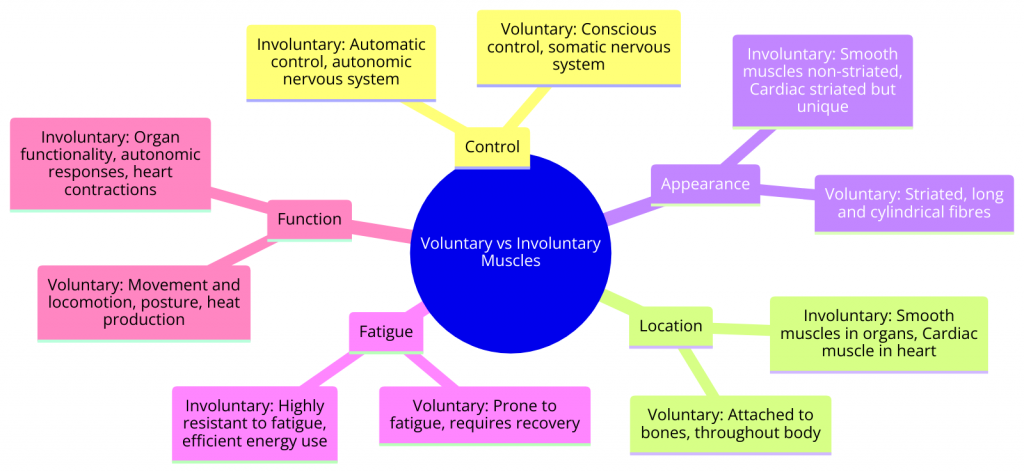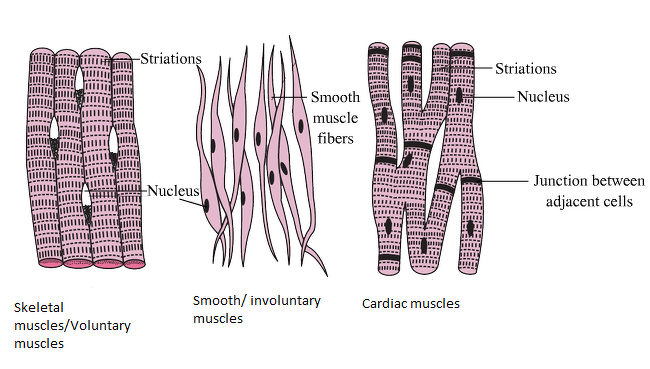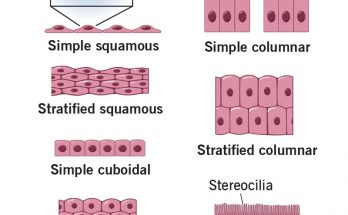Table of Contents
Voluntary Muscles
What are Voluntary Muscles?
Voluntary muscles, also known as skeletal muscles, are the muscles you consciously control to move parts of your body. These are the muscles you use when you decide to perform actions like walking, writing, or jumping.
Key Characteristics of Voluntary Muscles
Control-
- You have the ability to control these muscles voluntarily. This means you decide when and how to use them. For example, choosing to stand up involves consciously using your voluntary muscles to lift your body.
Appearance-
- When observed under a microscope, voluntary muscles show a distinct pattern of light and dark bands, giving them a striped or “striated” appearance. This pattern is due to the arrangement of muscle fibres and the proteins that cause muscle contraction.
Fatigue-
- With prolonged or intense use, voluntary muscles can become tired or fatigued. This happens because the muscles deplete their energy reserves and accumulate waste products, leading to a decrease in performance and the sensation of fatigue.
Examples-
- Examples of voluntary muscles include the biceps in your arms and the hamstrings in your legs. These muscles allow you to perform a wide range of movements and activities.
Importance in Daily Life
How voluntary muscles work is crucial not just for biology but for everyday life. It explains how we move and interact with our surroundings, the importance of exercise in strengthening these muscles, and why rest is necessary to recover from fatigue and prevent injuries.
Involuntary Muscles
What are Involuntary Muscles?
Involuntary muscles are muscles that operate without your conscious control. They handle essential functions in your body, like pumping your heart, moving food through your digestive system, and controlling the flow of blood in your arteries.
Key Characteristics of Involuntary Muscles
Control-
- These muscles function automatically. You don’t decide to do things like digesting food or circulating blood; your body takes care of these functions on its own, thanks to involuntary muscles.
Types of Involuntary Muscles-
- There are two main types, each with a unique role and location in the body.
Smooth Muscles-
- Location- Found in the walls of internal organs, such as the stomach, intestines, bladder, and blood vessels.
- Appearance- Under a microscope, smooth muscles don’t show the striations (stripes) that you see in voluntary muscles. This is why they’re called “non-striated” muscles.
- Function- They help move substances through organs, like pushing food through your digestive system, and regulating blood pressure by controlling the size of blood vessels.
Cardiac Muscle-
- Location- This muscle is found only in your heart.
- Appearance- Cardiac muscle fibres do have striations, similar to voluntary muscles, but they are structured differently to support continuous, rhythmic contractions.
- Function- Cardiac muscles work involuntarily to pump blood throughout your body, ensuring oxygen and nutrients are delivered to all your cells.
Importance in Daily Life
Involuntary muscles help you appreciate the complex, automatic processes your body performs to keep you alive and healthy. These muscles work tirelessly behind the scenes, supporting vital functions without any need for conscious thought.

Voluntary muscles and Involuntary Muscles Example
Examples of both voluntary and involuntary muscles to illustrate the types of actions they control and where they are located in the body –
Voluntary Muscles – Examples
- Biceps Brachii: The muscle in the front of the upper arm that flexes the elbow and rotates the forearm.
- Quadriceps: A group of muscles on the front of the thigh that extends the knee and is used heavily in walking, running, and jumping.
- Hamstrings: Located on the back of the thigh, these muscles bend the knee and help in hip extension.
- Deltoids: Shoulder muscles that are responsible for a wide range of arm movements, including lifting and rotating the arm.
- Gastrocnemius: The calf muscle that flexes the foot and aids in walking and jumping.
Involuntary Muscles -Examples
Smooth Muscles:
- Intestinal Muscles: These muscles work in the digestive tract to move food along through peristalsis.
- Muscles in Arteries: Regulate blood pressure by constricting or dilating to control blood flow.
- Uterine Muscles: Contract during childbirth to help deliver the baby.
Cardiac Muscle:
- Myocardium: The muscular wall of the heart, which contracts to pump blood out of the heart and then relaxes as the heart refills with returning blood.
Difference between Voluntary and Involuntary muscles
Difference between Voluntary and Involuntary muscles in tabular format
| Feature | Voluntary Muscles | Involuntary Muscles |
| Control | Consciously controlled; movements are deliberate. | Automatically controlled; operate without conscious thought. |
| Location | Attached to bones; involved in skeletal movement. | Found in internal organs and blood vessels; not attached to bones. |
| Appearance | Striated with visible banding under a microscope. | Smooth muscles are non-striated; cardiac muscles are striated but have a unique structure with intercalated discs. |
| Fatigue | Can become fatigued with excessive use. | Highly resistant to fatigue, designed for continuous operation. |
| Function | Responsible for movement, posture, and heat production. | Regulate internal functions like blood flow, digestion, and heartbeats. |
Difference between Voluntary and Involuntary muscles in Details
Difference between Voluntary and Involuntary muscles in terms of Control
Difference between voluntary and involuntary muscles in terms of control lies in how they are regulated and activated-
Voluntary Muscles-
- Conscious Control- You have direct control over these muscles through conscious thought. For example, when you decide to pick up a book, your brain sends specific signals to the voluntary muscles in your arm and hand to perform that action.
- Nervous System Involvement- The somatic nervous system, a part of the peripheral nervous system, is responsible for voluntary muscle control. It processes voluntary movements initiated by the brain and sends motor signals to the specific muscles involved.
- Precision and Volition- Voluntary muscle movement can be highly precise and is used for complex, coordinated actions, from speaking to playing a musical instrument.
Involuntary Muscles-
- Automatic Control- These muscles operate without the need for conscious thought. They perform essential functions like pumping blood, digesting food, and regulating blood pressure automatically.
- Nervous System Involvement- The autonomic nervous system (ANS) controls involuntary muscles. This system operates below the level of consciousness and regulates the function of internal organs.
- Reflexive and Rhythmic Actions- Involuntary muscle actions are often reflexive or rhythmic, such as the heartbeat or peristalsis in the digestive tract, and continue without any conscious intervention.
Difference between Voluntary and Involuntary muscles in terms of Location
Location of voluntary and involuntary muscles within the body highlights another key difference between the two-
Voluntary Muscles-
- Attached to Bones- Voluntary muscles, also known as skeletal muscles, are primarily attached to bones via tendons. This connection facilitates movement of the skeleton.
- Throughout the Body- They are distributed throughout the body, wherever movement and force exertion are needed, including the arms, legs, back, chest, and face.
Involuntary Muscles-
- Smooth Muscles- Found in the walls of internal organs such as the stomach, intestines, bladder, and blood vessels. These muscles help in processes like digestion, blood flow regulation, and control of the urinary and reproductive systems.
- Cardiac Muscle- Located exclusively in the heart. Its specialised structure and function are dedicated to pumping blood throughout the body.
Difference between Voluntary and Involuntary muscles in terms of Appearance
The appearance of voluntary and involuntary muscles, especially under microscopic examination, reveals distinct differences-
Voluntary Muscles-
- Striated Appearance- Voluntary muscles, also known as skeletal muscles, have a striated or striped appearance when viewed under a microscope. This striation comes from the organised arrangement of muscle fibres and the repeating units of sarcomeres, which are the contractile units of the muscle fibres.
- Long and Cylindrical Fibres- The muscle fibres in voluntary muscles are long, cylindrical, and multinucleated, allowing for powerful and sustained contractions.
Involuntary Muscles-
Smooth Muscles-
- Non-striated Appearance- Smooth muscles lack the striated appearance of voluntary muscles, hence the name “smooth.” This is due to the more random organisation of actin and myosin filaments within the muscle cells.
- Spindle-shaped Cells- The individual muscle cells are spindle-shaped and have a single nucleus. These cells are smaller than the fibres found in voluntary muscles.
Cardiac Muscle-
- Striated but Unique- Cardiac muscle, while striated like voluntary muscles, has a unique appearance due to the presence of intercalated discs. These discs connect cardiac muscle cells and help synchronise their contraction.
- Branched Fibres- Cardiac muscle fibres are shorter than skeletal muscle fibres, branched, and typically have a single nucleus per cell. The branching and interconnections facilitate the spread of electrical impulses for coordinated heart contractions.
Also Check – Difference between Voluntary and Involuntary Action
Difference between Voluntary and Involuntary muscles in terms of Fatigue
The way voluntary and involuntary muscles experience fatigue varies significantly due to their structure and function-
Voluntary Muscles-
- Prone to Fatigue- Voluntary muscles can tire out relatively quickly with continuous use. This fatigue results from the depletion of energy reserves (like ATP and glycogen) within the muscle cells and the accumulation of metabolic byproducts (like lactic acid) that interfere with muscle contraction.
- Recovery Required- After intense or prolonged activity, voluntary muscles need rest and recovery time. This allows for the replenishment of energy stores and the removal of metabolic waste products.
Involuntary Muscles-
- Highly Resistant to Fatigue- Involuntary muscles, especially cardiac muscles, are designed to work continuously without tiring. This is crucial for life-sustaining functions such as heartbeats and peristalsis in the digestive system.
- Efficient Energy Use- These muscles have a high density of mitochondria, which are the powerhouses of the cell. This allows for efficient energy production and use, helping to stave off fatigue.
- Adaptive Functioning- Involuntary muscles can adjust their workload without significant fatigue, ensuring essential bodily functions remain uninterrupted over time.
Difference between Voluntary and Involuntary muscles in terms of Function
The functions of voluntary and involuntary muscles differ significantly, reflecting their distinct roles in the body-
Voluntary Muscles-
- Movement and Locomotion– Voluntary muscles, also known as skeletal muscles, are primarily responsible for moving the skeleton. They enable activities like walking, running, jumping, and manipulating objects.
- Posture and Stability- These muscles help maintain posture and stabilise joints, providing support to the skeletal structure.
- Heat Production- During physical activity, voluntary muscles generate heat as a byproduct of energy expenditure, helping to maintain body temperature.
Involuntary Muscles-
Smooth Muscles-
- Organ Functionality- Smooth muscles in the walls of internal organs like the stomach, intestines, and blood vessels regulate the flow of substances through these organs. For example, they control the movement of food through the digestive system (peristalsis) and regulate blood pressure by altering the diameter of blood vessels.
- Autonomic Responses- These muscles also mediate involuntary responses like pupil dilation and constriction in response to light.
Cardiac Muscle-
- Heart Contractions- The primary function of cardiac muscle is to contract rhythmically and continuously to pump blood throughout the body. This ensures the delivery of oxygen and nutrients to tissues and the removal of waste products.
Similarities between Voluntary and Involuntary muscles
Despite their differences, voluntary and involuntary muscles share some similarities-
- Basic Function- Both types of muscles are involved in creating movement, either by moving the body in the environment (voluntary) or by moving substances within the body (involuntary).
- Cellular Structure- Both muscle types are made up of muscle fibres, which are the cells that contract and enable muscle movement. These fibres contain the proteins actin and myosin, which interact to cause muscle contraction in both voluntary and involuntary muscles.
- Energy Use- Both types of muscles require energy (ATP) to function and contract. They both utilise similar metabolic pathways to generate this energy, although the demand and efficiency can vary between the two types.
- Response to Stimuli- Both voluntary and involuntary muscles can respond to stimuli. For voluntary muscles, the stimulus is usually a conscious signal from the brain. Involuntary muscles respond to unconscious signals from the autonomic nervous system or to local conditions in their environment (like stretching or chemical signals).
- Repair and Growth- Both muscle types have the ability to repair themselves and can adapt to increased demand. For voluntary muscles, this is often seen as muscle growth with exercise. Involuntary muscles, particularly smooth muscles, can also grow and remodel in response to increased demand.

